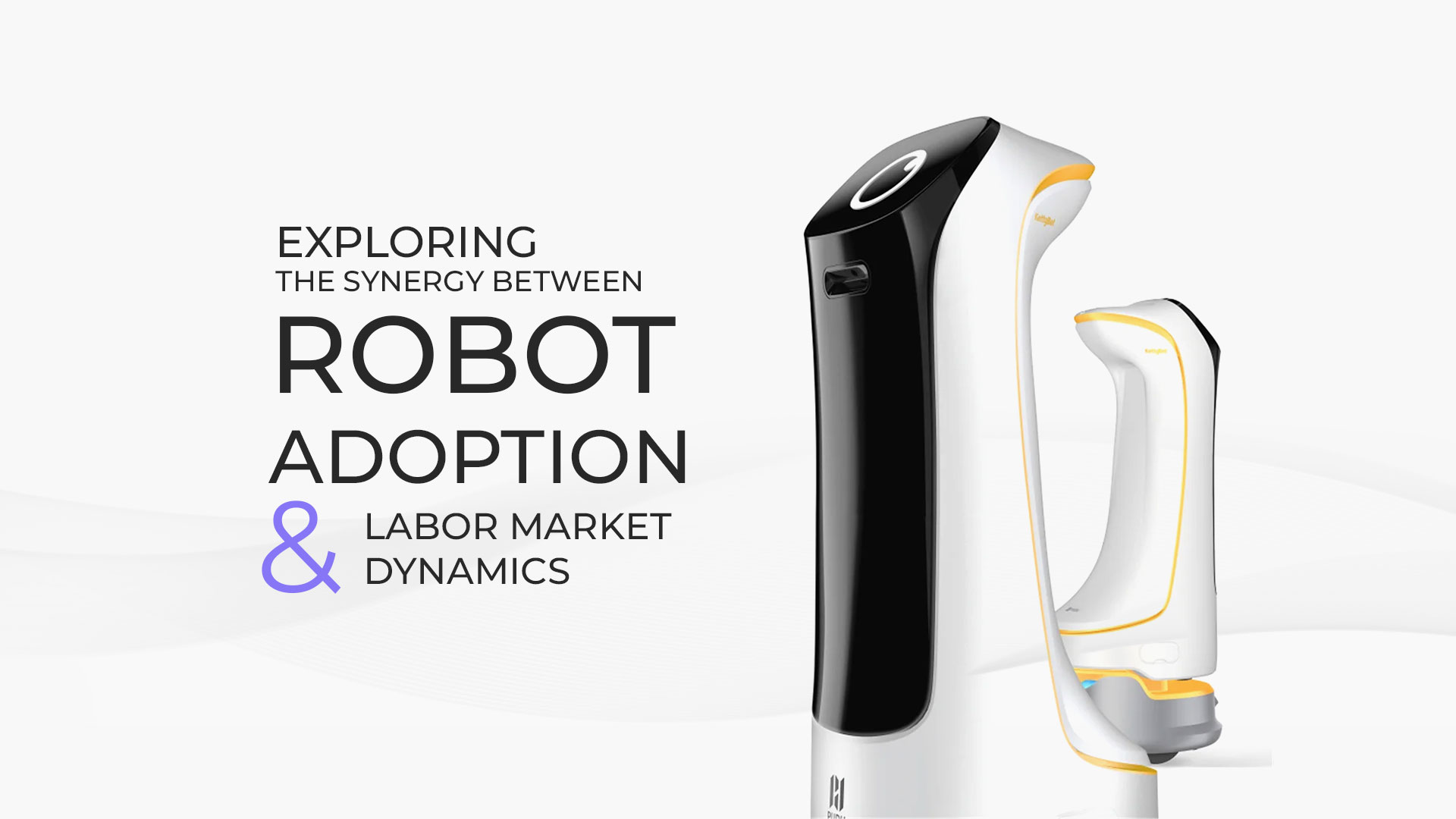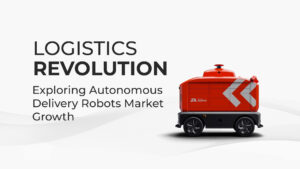Will robots steal our jobs, or create new ones? It’s a question that lingers in the air as the world witnesses an unprecedented surge in the adoption of robotic technologies. In this age of technological evolution, the dynamics between robots and jobs are undergoing a profound transformation, paving the way for a future that is both promising and uncertain.
As industries worldwide are increasingly embracing the era of automation, the intersection of robot adoption and labor market dynamics has become a focal point of discussion, so let’s start with Understanding both:
- Robot adoption refers to the incorporation of automated systems and artificial intelligence into various facets of industries, ranging from manufacturing to service sectors.
- On the other hand, labor market dynamics meaning the fluidity and responsiveness of the job market to various factors such as technological advancements, economic shifts, and societal changes.
As we embark on this journey, we will navigate through real-world examples, challenges, and future prospects, aiming to unravel the complexities and shed light on the potential paths ahead in this transformative era of technology and employment.
Table of Contents
The Current Landscape of Robot Adoption
The once futuristic scene of robots seamlessly integrated into the workforce is no longer a figment of science fiction. We’re witnessing a surge in robot adoption across industries, transforming how we operate, produce, and even care for one another. Let’s delve into the dynamic landscape of robots in the workplace, exploring the reasons behind their rise and the implications for our future.
Statistics Paint a Thriving Picture
Global robot installations are experiencing explosive growth, with the International Federation of Robotics (IFR) estimating a 32% increase in 2023 alone. The automotive industry remains the biggest adopter, followed by the electronics and metalworking sectors. However, the rise of collaborative robots (cobots) designed for safe human-robot interaction is opening doors for increased automation in sectors like healthcare, logistics, and even agriculture.
Industry Champions: Early Adopters Leading the Way
Several companies and sectors stand out as trailblazers in embracing robotic technologies. Here are a few prominent examples:
- Logistics Giants: Amazon has revolutionized warehouse operations with fleets of Kiva robots retrieving and transporting goods, significantly boosting efficiency and accuracy.
- Automotive Pioneers: Ford’s Kuga production line in Spain relies heavily on collaborative robots for tasks like welding and assembly, demonstrating the potential for human-robot collaboration in manufacturing.
- Surgical Precision: Intuitive Surgical’s da Vinci® robot system has transformed minimally invasive surgery, offering surgeons enhanced dexterity and control, leading to improved patient outcomes.
Understanding Labor Market Dynamics: A Shifting Landscape
Before we dive into the intricate dance between robots and workers, let’s set the stage by understanding the very ground we stand on: the dynamic and ever-shifting realm of labor market dynamics.
Supply and Demand
Imagine a bustling marketplace, not for goods, but for skills and capabilities. That’s essentially the labor market. On one side, we have workers, offering their skills and experience in exchange for wages and benefits. On the other, we have employers, seeking those skills to fulfill their business needs. The interplay between these two forces, dictates the rhythm of the labor market.
Influencing Factors
The melody of the labor market isn’t played solely on the strings of supply and demand. A complex symphony of factors orchestrates its rhythm:
- Economic Trends: Booming economies generally see increased demand for labor, leading to higher wages and lower unemployment.
- Technological Advancements: Automation, as we’ll explore later, can displace certain jobs while creating new ones in related fields.
- Government Policies: Policies like minimum wage hikes or tax breaks for specific industries can directly impact labor costs and job creation.
- Education and Training: The availability of skilled workers plays a crucial role in matching employer needs with available talent.
Adapting to Change
Traditionally, the labor market operated at a slower pace. Skills development took time, job changes were less frequent, and industries evolved gradually. However, the digital revolution has injected a frenetic tempo into the dance. Technological advancements disrupt industries at breakneck speed, demanding constant adaptation of skills and job roles.
By understanding the key components and influencing factors of labor market dynamics, we can better navigate the changing landscape and prepare ourselves for the intricate interplay with the rising star of robot adoption. Stay tuned!
Exploring the Synergy between Robot Adoption and Labor Market Dynamics
The dance between humans and machines in the workplace is becoming ever more intricate, propelled by the rising tide of robot adoption. This phenomenon, a key aspect of labor market dynamics, presents both exhilarating potential and daunting challenges.
Robots as Productivity Partners
Consider sectors like manufacturing, where industrial robots seamlessly integrate with human teams. These tireless assistants handle heavy lifting and monotonous tasks, boosting efficiency and safety. This productivity surge doesn’t translate to job losses; it frees up human workers to focus on higher-level tasks like design, quality control, and data analysis. In healthcare, surgical robots enhance precision and minimize risks, allowing surgeons to dedicate more time to complex procedures and patient care.
These examples highlight how robots, when implemented strategically, can complement and amplify human skills, paving the way for new job opportunities in areas like robot design, maintenance, and data management.
The Need for Reskilling
However, not all jobs are immune to the changing landscape. Routine, rule-based tasks are particularly vulnerable to automation. This underscores the need for upskilling and reskilling initiatives to equip the workforce with the skills and knowledge required to thrive in the age of automation. we can ensure a smoother transition for affected workers and empower them to embrace new opportunities.
– This intricate interplay between robot adoption and labor market dynamics demands a nuanced approach. It’s not about humans versus machines; it’s about harnessing the collective strengths of both to build a future where technology augments human potential, creating a more productive, efficient, and ultimately, thriving workforce.
Case Studies: Real-World Examples of Thriving with Robots
While the narrative surrounding robot adoption often focuses on job displacement, numerous companies are demonstrating how embracing automation can benefit both efficiency and the workforce. Let’s explore two inspiring case studies:
Ford and the Rise of Collaborative Robots
Ford, the iconic American automaker, hasn’t shied away from robot adoption. However, their approach prioritizes complementary collaboration over replacement. In their Kentucky Truck Plant, robots seamlessly work alongside human workers.
The results speak for themselves. Ford has seen a 20% increase in productivity due to robot adoption. Cobots handle repetitive tasks, allowing human workers to focus on higher-level skills like quality control and innovation.
Robots Revolutionize Healthcare at Mayo Clinic
The healthcare industry is also embracing robot adoption, but with a focus on precision and patient care. The Mayo Clinic, a world-renowned medical center, leverages robots for a variety of tasks, including:
- Minimally invasive surgery: Robotic arms assist surgeons with delicate procedures, improving accuracy and minimizing patient trauma.
- Pharmacy automation: Robots manage medication dispensing, reducing errors and freeing up nurses for patient interaction.
- Rehabilitation therapy: Robotic exoskeletons help patients regain mobility and function, leading to faster recovery times.
These advancements illustrate how robot adoption in healthcare doesn’t replace human healthcare professionals; it augments their abilities and frees them to focus on higher-level care.
– These are just two examples of how diverse industries are successfully navigating the complex dynamics of robot adoption.
Embracing the Future Together
In this era of unprecedented technological evolution, the intersection of robot adoption and labor market dynamics unfolds as a transformative force, shaping the future of work. As we witness the rise of robots across industries, it’s evident that the narrative isn’t about job displacement but rather a harmonious collaboration between humans and machines, By investing in education, fostering human-robot collaboration, and establishing robust ethical frameworks, we can ensure that robot adoption empowers, not displaces, the workforce. It’s a call to action—navigate change, embrace reskilling, and upgrade your work with Proven Robotics for a future where technology and humanity thrive together. Upgrade today and be part of the journey towards a more productive, efficient, and ultimately, flourishing workforce.




